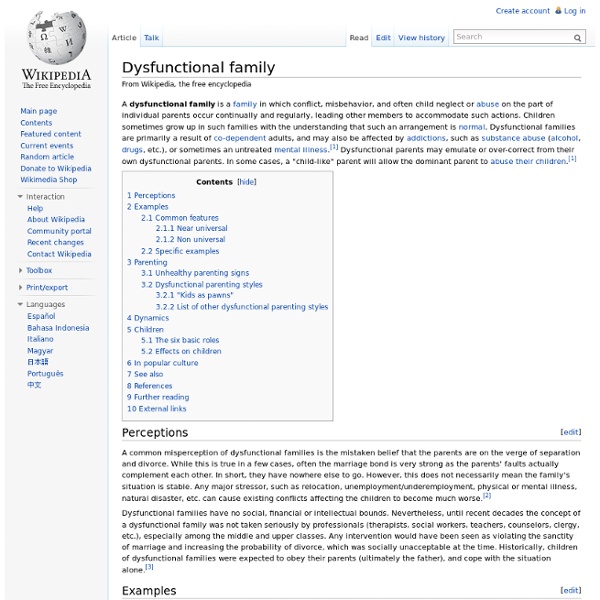Dysfunctional family

Dysfunctional Family Patterns : Counseling Center : Texas State University
Breaking Free of Dysfunctional Family Patterns Everyone has had a conflict with their family at some time or another, but for some it is more of a lifetime struggle involving much confusion and emotional pain. Many students come to college thinking that this change will relieve them of their family stress. What is a "Dysfunctional Family"? The term is often overused and some people believe that every family is dysfunctional to some extent. extreme rigidity in family rules little or no communication high levels of tension and/or arguing extended periods of silence blame and avoidance as primary coping mechanisms overall message of "don’t feel, don’t talk, don’t trust" The family problem can take many different forms such as: battering/physical abuse of one or more family members inappropriate sexual behavior/sexual abuse emotional abuse chemical dependency compulsive eating/dieting compulsive gambling workaholism Transitions Breaking Free Building Support Remember
How Addiction Changes a Child’s Role in the Family – Scapegoat, Hero, Super Enabler, or Disappearing Act
We are thrilled to have a guest post from Ken Powers, co-author of We Codependent Men We Mute Coyotes. Below is an excerpt from his book as it pertains to childhood roles that persist when addiction is present. Post by: Ken Powers We will begin at the beginning and flesh out the codependent disease process as it relates to childhood with some concepts long accepted among program people about the roles typically played by children in dysfunctional homes. The Class/Family Clown draws attention away from the pain and dysfunction at home by entertaining others. “To diffuse the battles that often raged around us, or to divert our parents from their attacks on one another or other members of the family, some of us learned to entertain. The Scapegoat Child acts out, gets into trouble, and gains attention while deflecting attention away from the addicted parents. The Super Enabler is the child often closest to the addict emotionally.
[FOUR] Roles In Dysfunctional Families
by Robert Burney M.A. "We have come to understand that both the passive and the aggressive behavioral defense systems are reactions to the same kinds of childhood trauma, to the same kinds of emotional wounds. The Family Systems Dynamics research shows that within the family system, children adopt certain roles according to their family dynamics. The emotional dynamics of dysfunctional families are basic - and like emotional dynamics for all human beings are pretty predictable. The basic roles which I list below apply to American culture specifically, and Western Civilization generally - but with a few changes in details could be made to fit most any culture. There are four basic roles that children adopt in order to survive growing up in emotionally dishonest, shame-based, dysfunctional family systems. "Responsible Child" - "Family Hero" This is the child who is "9 going on 40." "Acting out child" - "Scapegoat" "Placater" - "Mascot" - "Caretaker" "Adjuster" - "Lost Child"
Understanding Dysfunctional Relationship Patterns in Your Family
Many people hope that once they leave home, they will leave their family and childhood problems behind. However, many find that they experience similar problems, as well as similar feelings and relationship patterns, long after they have left the family environment. Ideally, children grow up in family environments which help them feel worthwhile and valuable. They learn that their feelings and needs are important and can be expressed. Children growing up in such supportive environments are likely to form healthy, open relationships in adulthood. However, families may fail to provide for many of their children’s emotional and physical needs. Types Of Dysfunctional Families The following are some examples of patterns that frequently occur in dysfunctional families. There is a great deal of variability in how often dysfunctional interactions and behaviors occur in families, and in the kinds and the severity of their dysfunction. Resulting Problems Making Changes Special Considerations
Related:
Related:



